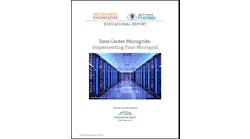S&C Electric’s David Chiesa describes a microgrid controller storm setting that can help utility recovery efforts when bad weather strikes.
As we’ve reached mid-fall, weather has quickly been changing, creating a mix of strong winds, heavy rain, snow, sleet—even hurricanes and tornados. And with this instability, all of this varying weather has the potential to occur in the same region over the course of hours or days, creating particular difficulty for affected power utilities to keep customers’ lights on. Those utilities that have established microgrids are best equipped to address the situation—and to do so most efficiently.
In a major storm like a hurricane or the remnants of one as it moves over land, as Hurricane Patricia did recently in Texas, microgrids operate similarly to a large facility protected by a bunch of security zones. If an alarm goes off in Security Zone 1, security staff can allocate resources to check out that zone, as well as nearby Zones 2, 3, and 4. Zone 5, however, is far enough away that the probability it is not affected is high, enabling security teams to zero in on the zones with the highest potential for a security breach.
Microgrids provide and use similar types of notification and response logic. A storm coming is a predictable event, but the damage it will do is not. So utilities don’t know exactly where on their system the damage is going to occur. With microgrids, utilities can break the zones down into districts, feeders, etc., that they monitor. They then can turn them on and say, “I’m going to separate this zone,” allowing response teams to focus their repair strategies more efficiently on affected zones.
Texas utility Oncor actually has a storm setting in its microgrid controller. When you set the microgrid controller to Storm, the grid focuses on 100 percent reliability. At that point, it brings all of the distributed generation up. It can even take the next step and separate one or more of its four microgrid zones from the grid, operating those zones as independent load sources during the storm.
Why would a utility want to do that? Because that creates “secure zones” it doesn’t have to address as it is handling recovery efforts on the rest of the system. With microgrids, it’s all about the recovery effort. What makes Oncor unique is it established a microgrid zone for a key facility it needs to manage recovery for the rest of the system. Its System Operating Services Facility is one of the places where Oncor stores materials to help in power-outage recovery efforts. Oncor crews now know to go there with the confidence the facility will have power when they need it, regardless of what rolls through.
Microgrids preemptively provide the support to protect the critical areas. Systems are hardened against incursions from the storm. At Oncor, normally there’s an economic dispatch engine working to use the energy-generation assets most economically during normal operations. In Storm mode, Oncor’s No. 1 system priority is reliability, survivability, and resilience. So it takes all the generation assets and capabilities and dedicates them toward the survivability of the system. It can also do some automated load shedding, where it systematically sheds load from some of the noncritical loads so it can preserve the critical loads on site.
Oncor, in essence, has secured its operations, much the way a security team would for its buildings.
How effective is your utility’s system at securing its grid against the rampages of a major storm? Is its method getting any better?






